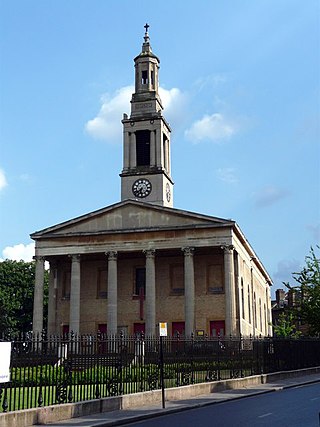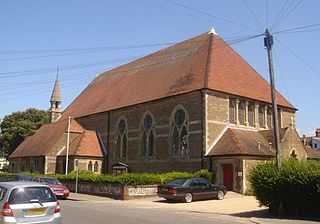
St Luke's Church in West Norwood is an Anglican church that worships in a Grade II* listed building. It stands on a prominent triangular site at the south end of Norwood Road, where the highway forks to become Knights Hill and Norwood High Street.

St John Horsleydown was the Anglican parish church of Horsleydown in Bermondsey, South London. Built for the Commission for Building Fifty New Churches to the designs of Nicholas Hawksmoor and John James in 1726–1733, it was noted for its distinctive spire in the form of a tapering column.

St Saviour's is an Anglo-Catholic church in Pimlico, City of Westminster, London, England, located at the north end of St George's Square. It was constructed in the 1860s as part of Thomas Cubitt's development of the area on behalf of the Marquess of Westminster. The church was designed by Thomas Cundy, who had previously built St Gabriel's Pimlico a short distance away. As with St Gabriel's, St Saviour's was designed in the Gothic style and built in ragstone to emphasise the contrast with the classical stucco of its secular neighbours. The church is Grade II listed.

St George's Church is an Anglican church in the East Worthing area of the borough of Worthing, one of seven local government districts in the English county of West Sussex. Built in 1867–68 to serve new residential development in the southeast of the town, the Decorated Gothic-style structure was extended later in the 19th century, and expanded its reach further by founding three mission halls elsewhere in Worthing. English Heritage has listed it at Grade C for its architectural and historical importance.

St Luke's Church is a United Reformed church in the Silverhill suburb of Hastings, a town and borough in East Sussex, England. The congregation was originally independent before taking up Presbyterianism, and worshipped in a private house from its founding in 1853 until a permanent church was provided in 1857; this was one of the oldest Presbyterian places of worship in southeast England. The growth of the community has resulted in several extensions since then, and severe damage caused by the Great Storm of 1987 was quickly repaired—except for the loss of the building's distinctive spire. The church, along with most other Presbyterian congregations, joined the United Reformed Church when that denomination was formed in 1972. It is one of four United Reformed Churches in the borough of Hastings.

St Matthew's Church is an Anglican church in the Silverhill suburb of Hastings, a town and borough in the English county of East Sussex. The present building, a large brick structure of 1884 by ecclesiastical architect John Loughborough Pearson, replaced a much smaller church founded in 1860 when Silverhill began to grow from an agricultural area with scattered cottages into a suburb of the increasingly fashionable seaside resort of Hastings. Although a planned tower was never built, the "imposing" church dominates its steeply sloping site; and although its architect—a leading Gothic Revivalist—considered it one of his lesser works, it has been described as "outstanding" and "architecturally inventive". English Heritage has listed the building at Grade II* for its architectural and historical importance.

The Parish Church of St Luke, Chelsea, is an Anglican church, on Sydney Street, Chelsea, London SW3, just off the King's Road. Ecclesiastically it is in the Deanery of Chelsea, part of the Diocese of London. It was designed by James Savage in 1819 and is of architectural significance as one of the earliest Gothic Revival churches in London, perhaps the earliest to be a complete new construction. St Luke's is one of the first group of Commissioners' churches, having received a grant of £8,333 towards its construction with money voted by Parliament as a result of the Church Building Act of 1818. The church is recorded in the National Heritage List for England as a designated Grade I listed building. The gardens of St Luke's are Grade II listed on the Register of Historic Parks and Gardens.

St Edmund's Church is the Roman Catholic parish church of Godalming, a town in the English county of Surrey. It was built in 1906 to the design of Frederick Walters and is a Grade II listed building. The church stands on a "dramatic hillside site" on the corner of Croft Road just off Flambard Way close to the centre of the town.

St Mary's Church is a Church of England church in Plaistow in the (East-) London Borough of Newham. With the three churches of St Matthias’, St Martin's, and St Philip and St James’, it now forms part of the Parish of the Divine Compassion. Its Victorian building, designed by Sir Arthur William Blomfield in 1890-1894, was demolished in 1976. They now worship in a smaller church built in 1981.

St Michael's Church is a Church of England parish church on the Romford Road in Manor Park, east London.

St Paul's Church, East Ham or St Paul's Church, Burges Road is a Church of England parish church in East Ham, Newham, east London.

St Edmund's Church, Forest Gate or the Church of St Edmund, King and Martyr, Forest Gate is an Anglo-Catholic church in the Forest Gate area of Newham, east London. It is dedicated to Edmund the Martyr. It originated in 1895 as the Red Post Lane mission district of All Saints parish. It became a parish of its own in 1901, with a permanent church completed in 1932. It now forms part of the East Ham Team Parish alongside St Mary Magdalene's Church, St Bartholomew's Church and St Alban's Church.

The Church of the Ascension, West Ham, or Church of the Ascension, Victoria Docks, is a Church of England church on Baxter Road in West Ham, east London. It was first built in 1887 as a mission hall for St Luke's Church, later put under the charge of the Felsted School Mission, which prior to that had been working in Bromley. Between 1903 and 1907 a new church was built, with a separate parish split from St Luke's in 1905. The new parish opened a mission house for women workers in 1909.

St Luke's Church, Canning Town or St Luke's Church, Victoria Docks is a Church of England church, originally housed in a building on Boyd Road in the Royal Docks area of West Ham in east London.

St Andrew's Church was a Church of England church on Barking Road in Plaistow, east London. It began as a small mission built in 1860 on Whitwell Road by St Mary's Church, Plaistow. A permanent church designed by James Brooks opened in 1870 on a site just south of the northern outfall sewer embankment and a separate parish assigned to it the following year. A large central crossing tower with a pyramidal spire was planned but only completed as far as the ridge of the nave roof.
St Gabriel's Church, Canning Town was a Church of England church in Canning Town, east London. It originated as an undedicated iron church between the River Lea and the railway to the north of the Barking Road, on the site later used for the brick-built permanent church of St Gabriel's, consecrated in 1876. Initially a mission of All Saints Church, West Ham, it was given a parish of its own three years after the consecration, using parts of those of All Saints, St Mary's and St Andrew's. It was damaged in the London Blitz and demolished around 1955, with its parish split between St Matthias and St Luke's in 1961.
St James' Church, Forest Gate was a church in Forest Gate, east London. Its origins lay in an iron building constructed around 1870 to serve a conventional district. A parish was formed for it in 1881 from those of Emmanuel Church, All Saints and St John's and its permanent church completed the following year, with an organ moved from St Matthew's Church, Friday Street. The church was demolished in 1964 and for two years its congregation worshiped in the Durning Hall Community Centre's chapel until the parish was merged with that of St John's. A new church was built for the St James' congregation at northern end of St James Road in 1968. The congregation finally moved to St Paul's Church, Stratford in 2014, though the area that had formerly been St James' parish was instead transferred from St John's to St Saviour's the same year.

St Mary's Church, Ilford or St Mary's Church, Great Ilford is a Church of England parish church in Ilford in the London Borough of Redbridge. A new ecclesiastical parish for Great Ilford was split off from that of Barking in 1830 and its church building completed the following year. The church's principal benefactor was Robert Westley Hall-Dare, M.P. His daughter, Mary Hall-Dare, laid the foundation stone and the church was opened on June 9, 1831, by Charles James Blomfield, Bishop of London, “and the day was spent in general festivity from the highest to the lowest classes”. Its first vicar was appointed in 1837 - its advowson was initially vested in All Souls College, Oxford. A tower was added in 1866 and a chancel, lady chapel and vestries in 1920. St Clement's Church was completed as a chapel of ease for it in 1896, before becoming the parish's main church in 1902.

St Barnabas' Church, Woodford Green, is a Church of England church in Snakes Lane East, Woodford, London. It had its origins in a 1904 iron mission church – this was attached to St Paul's Church, Woodford. A permanent church was built between 1910 and 1911, with a lady chapel, organ chamber, chancel and two bays of an aisled nave – the nave was completed in 1964. The church was designed by E T Dunn, who also designed St Luke's Church, Ilford, and produced a proposed design for a new chapel screen at St Peter's Church, Bethnal Green. Parts of the parishes of St Paul's, All Saints Church, Woodford Wells, and Holy Trinity Church, South Woodford, were combined to form the new parish of St Barnabas in 1911.

The Church of St Barnabas and St James the Greater, Walthamstow, is an Edwardian era Church of England parish church in Walthamstow, East London. It is a Grade II* listed building.


















